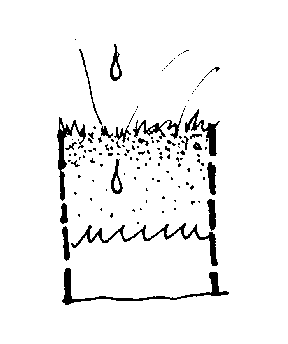ENVIRONMENTAL IMPACT
Design Considerations:
Restoration & Preservation of Fauna & Flora- Orient building on the site such that the building does not block
necessary sunlight to any vegetation in need of ample light. Native vegetation
should be maintained and retained. Any trees or vegetation that are planted on the
site must be compatible with species indigenous to the site. There must be no
planting of any species that could harm existing species. Reforestation should occur
during the landscaping phase. Sensitive habitat areas should be avoided. By
maintaining as much habitat as possible, nearby wildlife is encouraged to remain close to
human activities.
Groundwater control/ erosion control- Existing wetlands and
waterways should be maintained, not disturbed. Natural and indigenous grasses can be
planted to prevent erosion. Avoid building on slopes- the greater the slope, the
faster the land will erode.
Ecosystems (Water, Air & Soil)- All site and building
materials should be tested for levels of toxicity before installation. Preserve
existing surrounding environment. The site should have clean, uncontaminated water, air
and soil. Avoid construction in low-lying flood plain areas or on unstable soils,
taking protective measures to address adjacent water ecosystems and habitats.
Tools:
Ecosystems (Water, Air & Soil)- Devise a protocol for testing materials and
systems, new methodologies, or any choices that will need to be made.
Groundwater control/ erosion control-
Maryland Model Erosion and Sediment Control Ordinance- Sections 4.2 e & f
Maryland Model Stormwater Management Ordinance - Section 6 (Group 2)
Maryland Department of the Environment, Water Management Administration -Nonpoint Source
Program: (410) 6311-3543
Case Studies to research:
Restoration & Preservation of Fauna & Flora-
U.S. Fish and Wildlife National Conservation Training Center, Shepherdson, West Virginia.
KCF/SHG Architects
-National Wildflower Research Center, Austin, TX.
Overland Partners
Oceanside Water Pollution Control Plant, San Francisco, CA.
Simon Martin-Vegue Winkelstein Moris, Architect
Groundwater control/ erosion control-
Seneca Rocks Visitors' Center Monongahela National Forest, Elkins, West Virginia
Susan Maxman Architects
Ecosystems (Water, Air & Soil)-
Moore Residence, Connecticut
Alfredo DeVido, Architect
Further Information:
"Lady Bird's Legacy", Dillon, David. Architecture. Vol.84, no.7,
July 1995, pp.68-74.
"High Dividends" Buchanan, Peter. Architecture. Vol.84, no.7, July 1995,
pp.76-83.
"Flora and Fauna", Mays, Vernon. Architecture. Vol.87, no.7, July 1998,
pp.68-75.
EPA Green Building Standards
Web resources:
U.S. Department of Energy: EPIC -
Pollution Prevention Information Clearinghouse
Idaho National Engineering Laboratory,
Enviro$en$e
National
Extension Water Quality Database
Universities Water Information Network |
|

